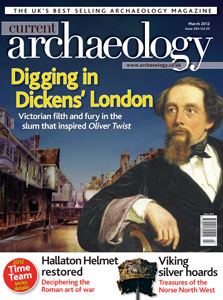February is the bicentenary of Dickens’ birth. Revered for his vivid descriptions of Victorian London, he is also applauded for drawing attention to the plight of the poorest in society. One of the slums he visited was Jacob’sIsland, which became the backdrop to the thrilling d√É©nouement of Oliver Twist. Yet while the level of squalor seemed like a grotesque caricature to some Victorian and modern commentators, recent excavations have revealed deprivation on a chilling scale.
What stories can the artefacts in national museums tell us about those countries? We explore how objects both everyday and exclusive combine to tell the 230,000 year tale of the birth of Wales.
Viking finds are rare in the North West. The discovery of two hoards in 2011 provides a rare glimpse of the international reach of the Danelaw. Amongst the coin issuers is a previously unknown Viking ruler, whose reign was most likely cut short by the turbulent events of his time.
The largest excavation ever undertaken in Cambridgeshire has revealed how the landscape evolved from the Bronze Age through to the modern day. A Roman memorial garden and bizarre late monument are amongst the intriguing discoveries in the Cam valley.
Finally, January saw the last pieces slotted into a Roman jigsaw puzzle almost a decade in the solving. The Hallaton cavalry helmet is now on public display. Read all about the messages conveyed by this masterpiece of imperial propaganda.
FEATURES/n
DIGGING JACOB’S ISLAND/n
A new chapter for Oliver Twist
Uncovering the ‘Capital of Cholera’: what light can archaeology shed on Charles Dickens’ most notorious slum?
TREASURES FROM EARLY WALES/n
Climate change, copper mining and the birth of the Cymry
Exploring 230,000 years of human activity through the superb collections of the National Museum Cardiff.
VIKING HOARDS/n
Buried wealth of the Norse North West
Commerce, Christianity and an unknown king: what can two remarkable detectorist finds reveal about Viking activity in north-west England?
CLAY FARM’S EVOLVING LANDSCAPE/n
From first farmers to post-Roman rituals
The largest single excavation in the Cambridge area has uncovered 5000 years of prehistoric activity and some tantalising Romano-British features.
NEWS/n
A burial plot to rewrite Roman inhumations;London’s love token?; Cutting edge Neanderthal technology; Cash, cheque or firedog?; Unravelling the King’s Knot; Conserving Co. Durham’s POW camp; Protecting Scarborough’s Star find; European archaeology on display.
REGULARS/n
Conference
Exciting new details about our updated timetable of speakers.
Time Team
A sneak preview of what you can expect from Series 19.
Reviews
Dennis Jackson: a Northamptonshire Archaeologist
Sherds
Chris Catling’s irreverent take on heritage issues.
Odd Socs
The Pugin Society

